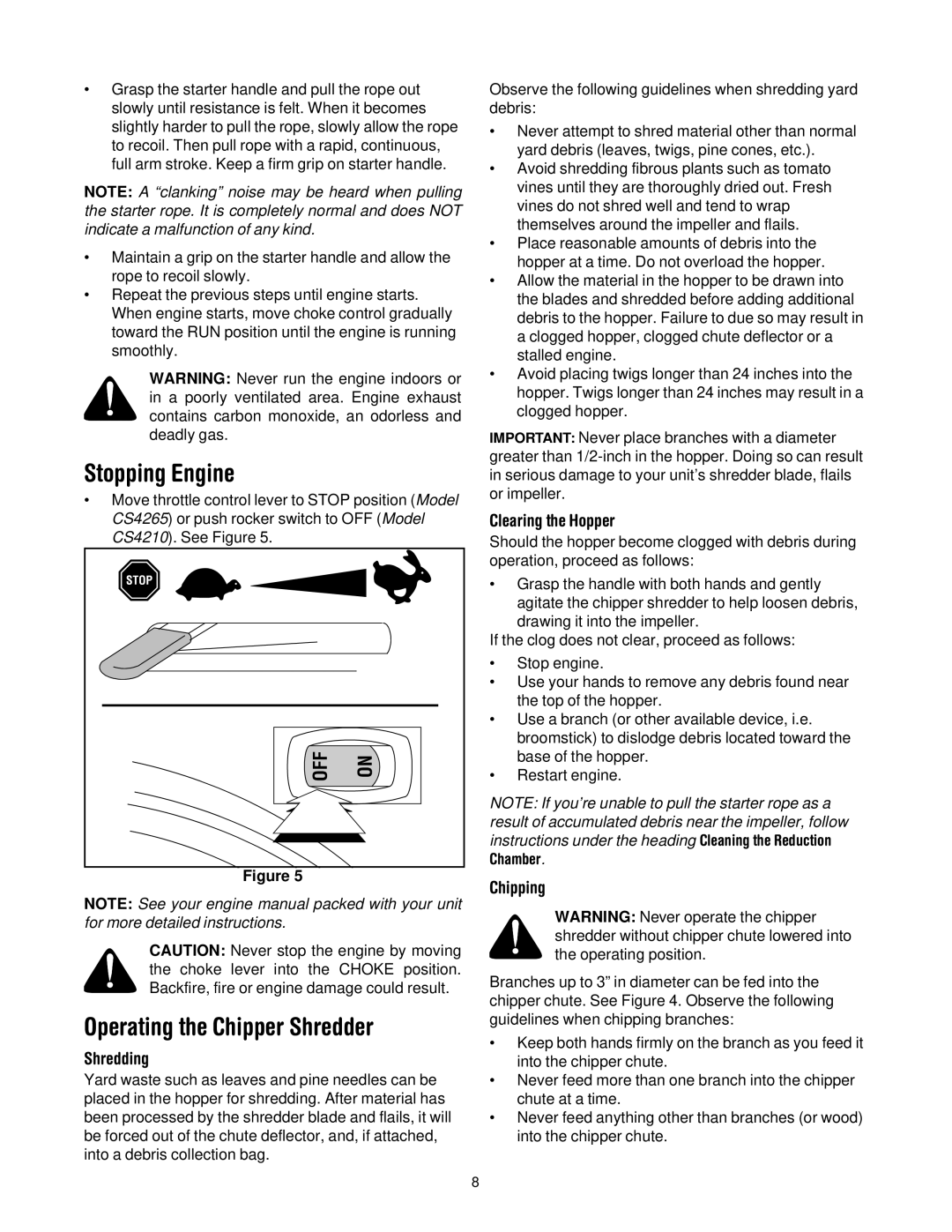
•Grasp the starter handle and pull the rope out slowly until resistance is felt. When it becomes slightly harder to pull the rope, slowly allow the rope to recoil. Then pull rope with a rapid, continuous, full arm stroke. Keep a firm grip on starter handle.
NOTE: A “clanking” noise may be heard when pulling the starter rope. It is completely normal and does NOT indicate a malfunction of any kind.
•Maintain a grip on the starter handle and allow the rope to recoil slowly.
•Repeat the previous steps until engine starts. When engine starts, move choke control gradually toward the RUN position until the engine is running smoothly.
WARNING: Never run the engine indoors or in a poorly ventilated area. Engine exhaust contains carbon monoxide, an odorless and deadly gas.
Stopping Engine
•Move throttle control lever to STOP position (Model CS4265) or push rocker switch to OFF (Model CS4210). See Figure 5.
Figure 5
NOTE: See your engine manual packed with your unit for more detailed instructions.
CAUTION: Never stop the engine by moving the choke lever into the CHOKE position. Backfire, fire or engine damage could result.
Operating the Chipper Shredder
Shredding
Yard waste such as leaves and pine needles can be placed in the hopper for shredding. After material has been processed by the shredder blade and flails, it will be forced out of the chute deflector, and, if attached, into a debris collection bag.
Observe the following guidelines when shredding yard debris:
•Never attempt to shred material other than normal yard debris (leaves, twigs, pine cones, etc.).
•Avoid shredding fibrous plants such as tomato vines until they are thoroughly dried out. Fresh vines do not shred well and tend to wrap themselves around the impeller and flails.
•Place reasonable amounts of debris into the hopper at a time. Do not overload the hopper.
•Allow the material in the hopper to be drawn into the blades and shredded before adding additional debris to the hopper. Failure to due so may result in a clogged hopper, clogged chute deflector or a stalled engine.
•Avoid placing twigs longer than 24 inches into the hopper. Twigs longer than 24 inches may result in a clogged hopper.
IMPORTANT: Never place branches with a diameter greater than
Clearing the Hopper
Should the hopper become clogged with debris during operation, proceed as follows:
•Grasp the handle with both hands and gently agitate the chipper shredder to help loosen debris, drawing it into the impeller.
If the clog does not clear, proceed as follows:
•Stop engine.
•Use your hands to remove any debris found near the top of the hopper.
•Use a branch (or other available device, i.e. broomstick) to dislodge debris located toward the base of the hopper.
•Restart engine.
NOTE: If you’re unable to pull the starter rope as a result of accumulated debris near the impeller, follow instructions under the heading Cleaning the Reduction Chamber.
Chipping
WARNING: Never operate the chipper shredder without chipper chute lowered into the operating position.
Branches up to 3” in diameter can be fed into the chipper chute. See Figure 4. Observe the following guidelines when chipping branches:
•Keep both hands firmly on the branch as you feed it into the chipper chute.
•Never feed more than one branch into the chipper chute at a time.
•Never feed anything other than branches (or wood) into the chipper chute.
8
